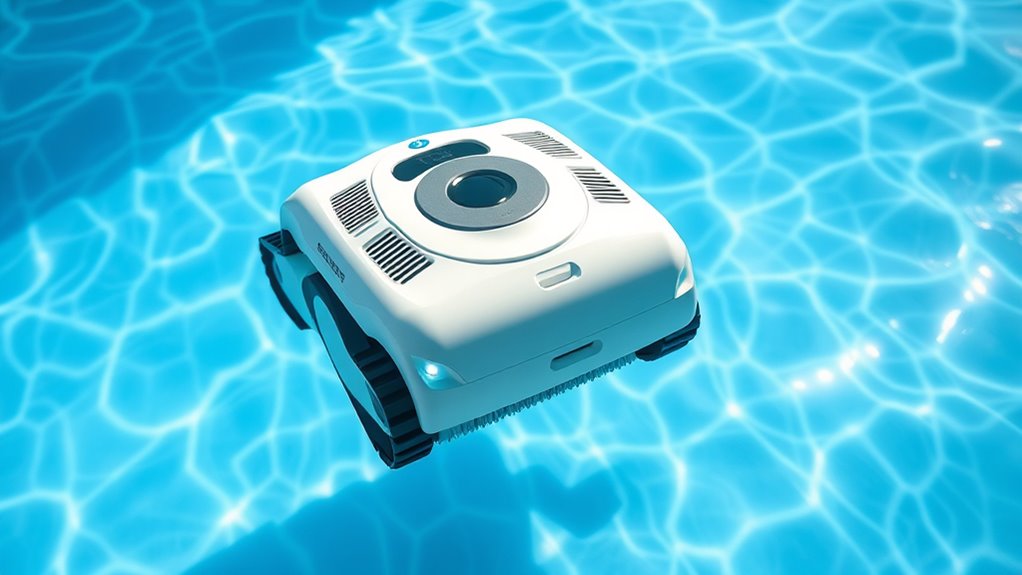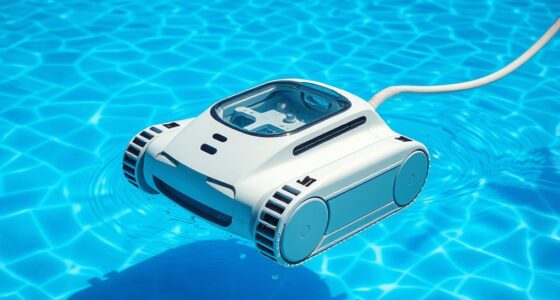Robotic pool cleaners work by combining durable hardware, smart sensors, and advanced navigation to find and remove debris from your pool automatically. They move across surfaces using systematic patterns, guided by sensors that map the pool and avoid obstacles. These devices use powerful brushes and suction to scrub walls and pick up dirt, powered by rechargeable batteries or wireless charging. If you’d like to discover more about how these efficient cleaners operate, keep exploring the details below.
Key Takeaways
- They use motors and brushes to scrub and vacuum debris from pool surfaces.
- Sensors detect obstacles, water conditions, and debris for navigation and cleaning efficiency.
- Advanced algorithms plan systematic paths, covering the entire pool area effectively.
- Powered by rechargeable batteries, often with wireless or solar charging options.
- User interfaces and apps allow easy scheduling, control, and monitoring of cleaning cycles.
Design and Structure of Robotic Pool Cleaners
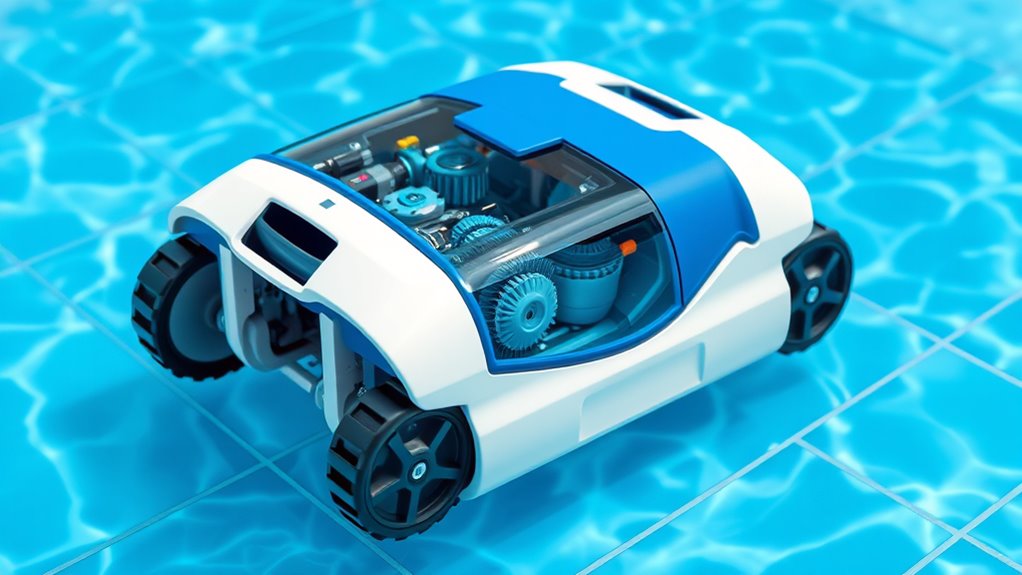
Have you ever wondered how robotic pool cleaners efficiently navigate and clean large pool surfaces? Their design and structure are key to their effectiveness. Most models feature a sturdy outer shell made of durable, waterproof plastic that withstands pool chemicals and water exposure. Inside, they house powerful motors and brushes that scrub and vacuum debris from the pool floor and walls. Their compact, lightweight design allows easy movement across surfaces, while integrated filters trap dirt and algae. Proper pool water chemistry is essential for ideal cleaning, as imbalanced chemicals can affect how well the cleaner works. Some models include replaceable filters designed to handle pool cleaning chemicals without damage. Additionally, corrosion resistance is a critical aspect of their construction, ensuring longevity despite constant exposure to chlorinated water. The navigation systems used in many models help them efficiently cover the entire pool area, preventing missed spots. Advanced sensor technology in robotic cleaners further enhances their ability to adapt to different pool shapes and obstacle layouts. Overall, their smart construction ensures thorough cleaning while resisting the corrosive effects of pool chemicals. Good water circulation also enhances the cleaner’s ability to effectively remove debris from all areas of the pool. A well-designed power management system helps optimize energy use and prolong the device’s operational life.
Sensors and Navigation Systems
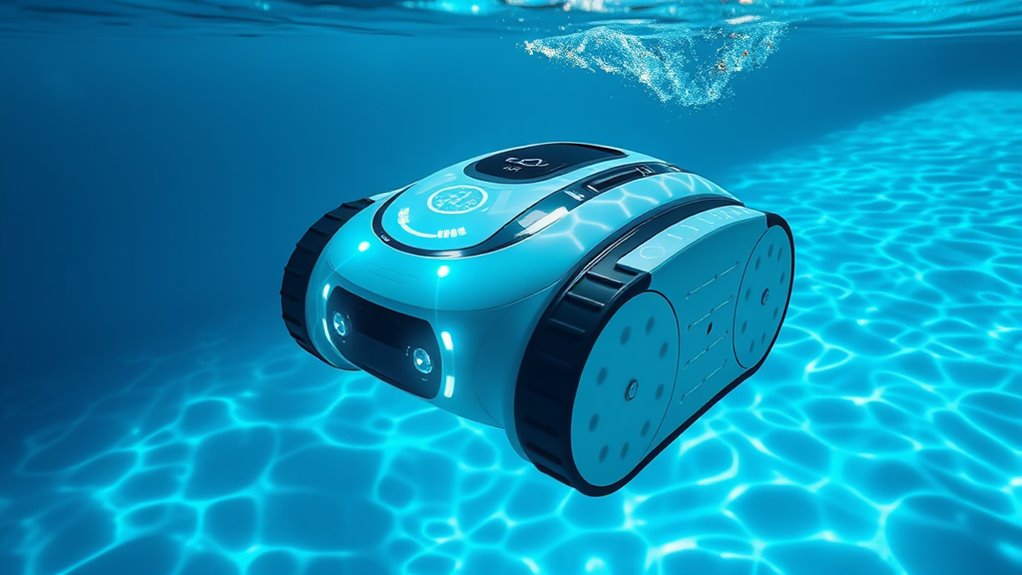
Robotic pool cleaners rely on various sensors to detect dirt, obstacles, and water conditions, ensuring efficient cleaning. Their navigation systems use path planning and mapping to cover the entire pool without missing spots. Understanding how these sensors and systems work helps you choose a model that fits your cleaning needs. Additionally, Kia Tuning modifications such as ECU remapping can optimize engine performance, paralleling how advanced sensor integration enhances the efficiency of robotic pool cleaners. The effectiveness of these systems depends on the quality of sensor technology employed, which constantly adapts to the pool’s environment for optimal results. Incorporating advanced navigation features can further improve coverage and reduce cleaning time, making the process even more efficient. Moreover, the integration of smart sensors allows for real-time adjustments, further increasing the cleaning effectiveness and conserving energy during operation.
Sensor Types and Functions
Sensors and navigation systems are the core components that enable robotic pool cleaners to operate efficiently and effectively. You rely on various sensor types, such as environmental sensors, to detect water temperature, pH levels, and debris presence. These sensors require regular sensor calibration to guarantee accurate readings, which helps optimize cleaning performance. Proximity sensors detect walls and obstacles, guiding the cleaner around the pool efficiently. Some models include infrared or ultrasonic sensors to map the pool’s layout and avoid obstacles. Each sensor type plays a vital role in providing real-time data, allowing the robot to navigate smoothly and clean thoroughly. By understanding these sensors’ functions, you can better appreciate how your robotic pool cleaner maintains your pool’s cleanliness.
Path Planning and Mapping
Path planning and mapping are essential for guaranteeing your robotic pool cleaner covers every inch of the pool efficiently. Using advanced navigation systems, your cleaner creates a map of the pool’s shape and features, avoiding missed spots. Sensors detect obstacles and water chemistry levels, helping the robot adjust its path to maintain ideal cleaning and ensure user safety. Efficient path planning prevents repetitive coverage and conserves battery life. Some models even remember the pool layout for future cleanings. By accurately mapping your pool, the cleaner reduces the risk of damaging surrounding equipment or affecting water chemistry. This precise navigation not only guarantees thorough cleaning but also promotes water safety, ensuring the pool remains clean and safe for swimmers. Smart navigation features enhance the overall effectiveness of robotic pool cleaners by adapting to changing pool conditions and improving cleaning performance.
Movement Algorithms and Path Planning
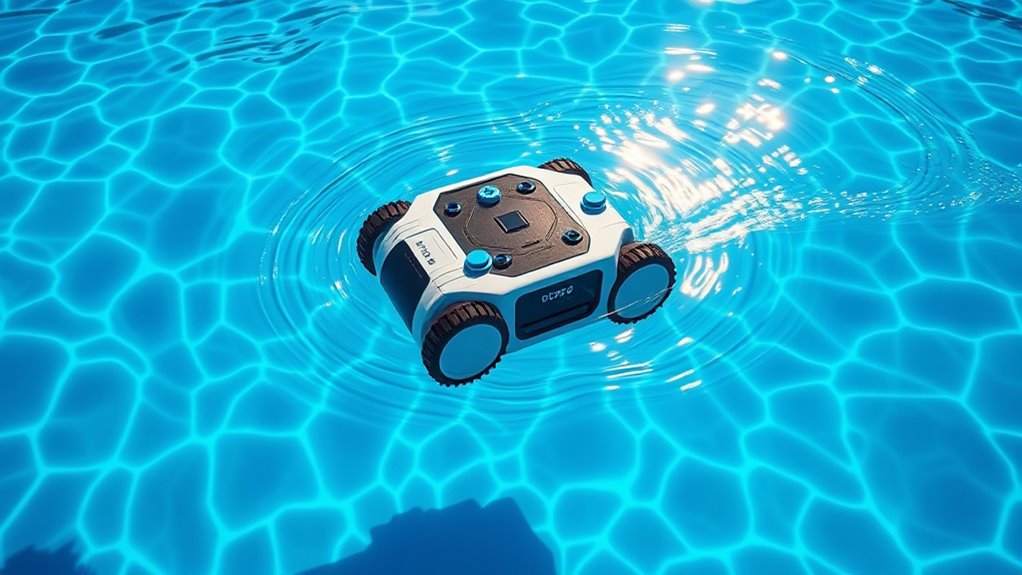
You’ll want to understand how robotic pool cleaners choose their paths to cover every inch effectively. They use various navigation patterns and obstacle detection techniques to avoid missed spots and bumps. By optimizing their routes, these cleaners guarantee thorough coverage while conserving energy.
Navigation Patterns and Routes
Robotic pool cleaners utilize sophisticated navigation patterns and routes to efficiently cover the entire pool surface. They often follow systematic paths to guarantee no area is missed, which helps maintain water chemistry by evenly distributing cleaning efforts. These cleaners adapt their routes based on pool size, shape, and lighting conditions, optimizing their coverage. You might notice them moving in straight lines, spirals, or grid patterns, depending on the model. Advanced models even remember obstacles or areas needing extra attention. Visualize the cleaner zigzagging across the pool, avoiding shadows cast by pool lighting, while ensuring the water stays clear. This precise navigation saves time and energy, providing thorough cleaning without missing spots or wasting effort. Incorporating navigation algorithms can be an analogy for how these cleaners follow specific, well-planned routes to ensure complete coverage. Additionally, some models utilize sensors to detect the pool’s layout and adjust their path dynamically, much like autonomous vehicles navigating complex environments. The use of sensor technology allows for more responsive and adaptable cleaning routes, further enhancing efficiency and effectiveness. Furthermore, understanding Mazda Tuning concepts such as route optimization can offer insights into how these cleaners maximize their coverage with minimal energy expenditure.
Obstacle Detection Techniques
To navigate efficiently and avoid obstacles, robotic pool cleaners employ advanced movement algorithms and path planning techniques. They use sensor fusion to combine data from multiple sensors, such as ultrasonic, infrared, and contact sensors, enabling accurate obstacle detection. When an obstacle is identified, the cleaner’s obstacle avoidance system adjusts its path in real-time, preventing collisions and ensuring thorough coverage. These algorithms analyze sensor inputs to determine the best route around objects, maintaining effective movement across the pool’s surfaces. By integrating sensor fusion with intelligent obstacle detection, robotic pool cleaners can adapt to changing environments, navigate complex areas, and optimize cleaning efficiency without getting stuck. Incorporating adaptive algorithms allows the devices to improve their navigation over time based on the environment. Knowledge of local regulations can also influence the design and operation of these devices to ensure safe and compliant functionality. This combination of techniques ensures a smooth, uninterrupted cleaning process.
Coverage Optimization Strategies
Effective coverage optimization is crucial for robotic pool cleaners to guarantee every inch of the surface gets cleaned efficiently. They use advanced coverage strategies and movement algorithms to ensure no area is missed. These strategies include systematic grid patterns, wall-following techniques, and random movement to maximize cleaning efficiency. Path planning considers obstacles and pool shape, allowing the robot to adapt its route dynamically. As a result, your cleaner spends less time and energy, delivering thorough results. To visualize these techniques:
- Systematic back-and-forth grid patterns
- Wall-following routes for edges and corners
- Random movement for irregular shapes
- Adaptive algorithms for obstacle navigation
- Zone-based cleaning for high-traffic areas
Together, these strategies optimize coverage, making your robotic pool cleaner highly effective and efficient. Incorporating software quality assurance best practices into the design process can help ensure the reliability and robustness of these movement algorithms. Additionally, implementing coverage analysis tools can further enhance the robot’s ability to effectively navigate complex pool environments.
Cleaning Mechanisms and Attachments
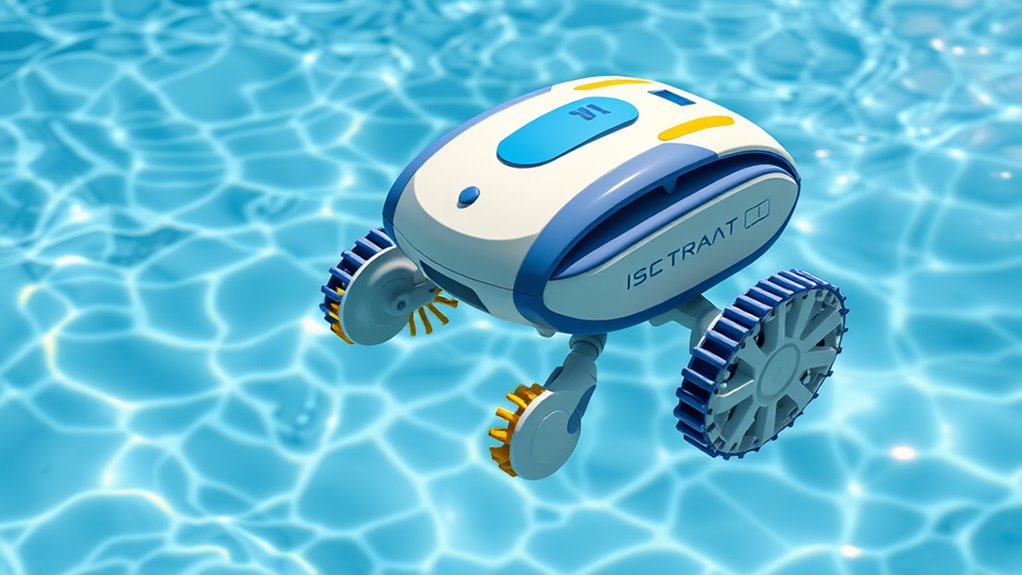
Cleaning mechanisms and attachments are the core features that determine how well a robotic pool cleaner can maintain your pool’s cleanliness. You’ll find different filter types, such as cartridge, diatomaceous earth, or sand filters, each suited for specific debris and water conditions. The cleaner’s cleaning attachments, like brushes, scrubbers, or vacuums, target dirt, algae, and debris on surfaces, guaranteeing thorough cleaning. Some models have rotating brushes that loosen stubborn dirt, while others rely on powerful suction to pick up debris. Attachments are often interchangeable, letting you customize the cleaner for your pool’s needs. By choosing the right filter types and attachments, you ensure ideal performance, efficient debris removal, and a sparkling clean pool with minimal effort. Additionally, navigation technology helps the robotic pool cleaner efficiently cover the entire pool surface, improving cleaning effectiveness. Incorporating advanced sensors allows the robot to detect obstacles and optimize its cleaning path, enhancing overall efficiency. Furthermore, understanding cleaning mechanisms helps in selecting the most suitable model for your pool size and type.
Power Supply and Battery Technology
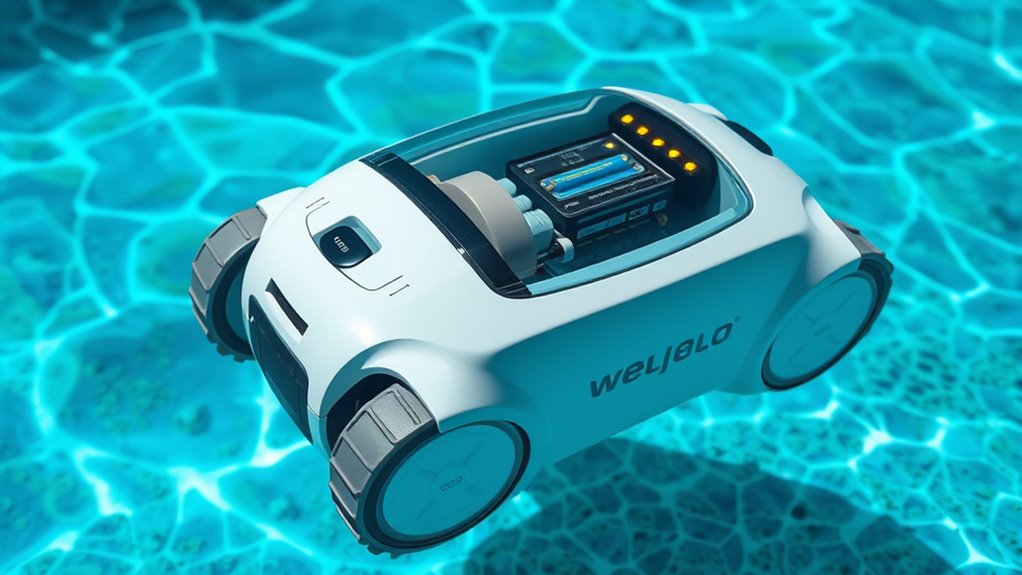
The power supply and battery technology in robotic pool cleaners directly impact their efficiency, runtime, and ease of use. Modern models often feature rechargeable batteries, with some offering wireless charging for convenience. Solar integration is also becoming popular, allowing the cleaner to recharge using sunlight, extending operating time. You’ll find batteries that range from standard lithium-ion to advanced solid-state, providing longer life and faster charging. Wireless charging pads enable you to simply dock the cleaner without cords, simplifying maintenance. Meanwhile, solar panels can supplement power, especially in sunny climates, reducing energy costs. Additionally, advancements in battery technology are enabling these devices to operate more reliably and for longer periods, making pool maintenance more effortless and environmentally friendly. Enhanced energy efficiency features further contribute to cost savings and sustainability. The integration of smart management systems further optimizes power usage and prolongs battery life, improving overall performance.
Control Systems and User Interface
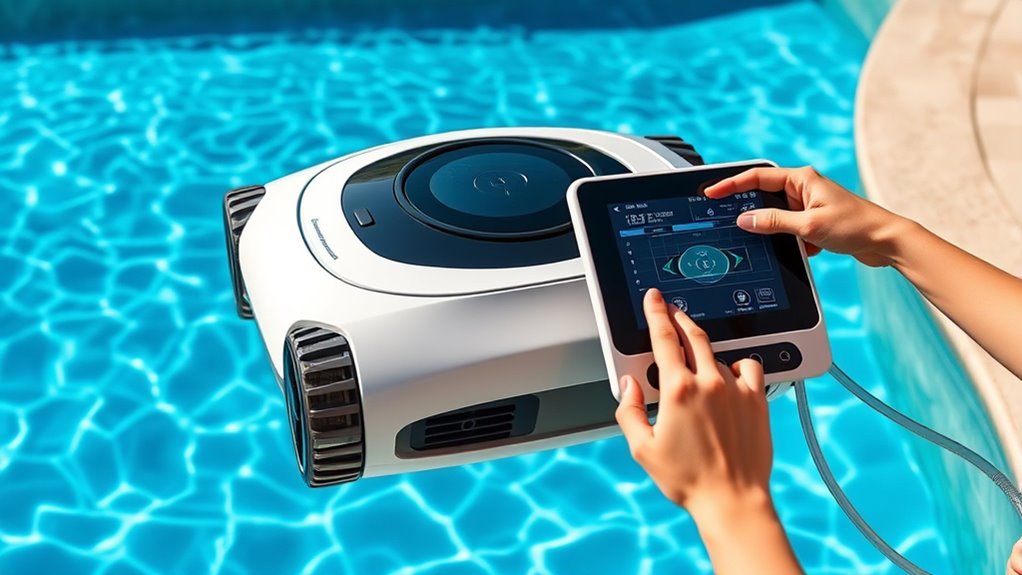
How do you guarantee your robotic pool cleaner is easy to operate and customize? It starts with an intuitive user interface that allows you to set cleaning schedules, select modes, and track progress effortlessly. Many models feature a remote control, giving you quick access to start, pause, or change cleaning patterns from a distance. These control systems simplify operation, so you don’t have to navigate complex menus or settings. Some cleaners also include smartphone apps, offering even more control and customization options at your fingertips. Clear displays and straightforward buttons help you understand the device’s status instantly. By choosing a cleaner with an accessible user interface and a reliable remote control, you ensure a hassle-free experience that adapts to your specific needs. Additionally, preventive maintenance can help keep your robotic cleaner functioning optimally for longer periods.
Maintenance and Troubleshooting
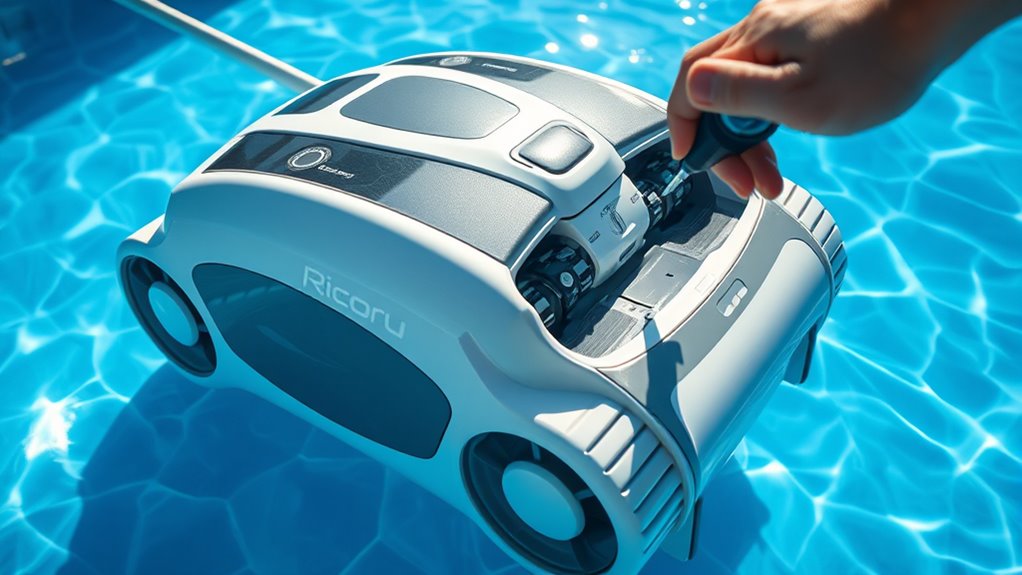
Regular maintenance is essential to keep your robotic pool cleaner functioning effectively and prevent future issues. Regularly check and clean the filter to ensure ideal suction and dirt removal. If you notice decreased performance, consider filter replacement promptly to avoid clogging. Inspect waterproofing techniques, like seals and gaskets, to prevent water damage and guarantee the device remains waterproof. Troubleshoot common problems, such as the cleaner not turning on or getting stuck, by examining its power connections and navigation system.
- Removing debris from brushes and wheels
- Replacing worn-out filters
- Inspecting and sealing waterproofing gaskets
- Clearing blockages in intake vents
- Checking and resetting the power supply
Advantages Over Traditional Cleaning Methods
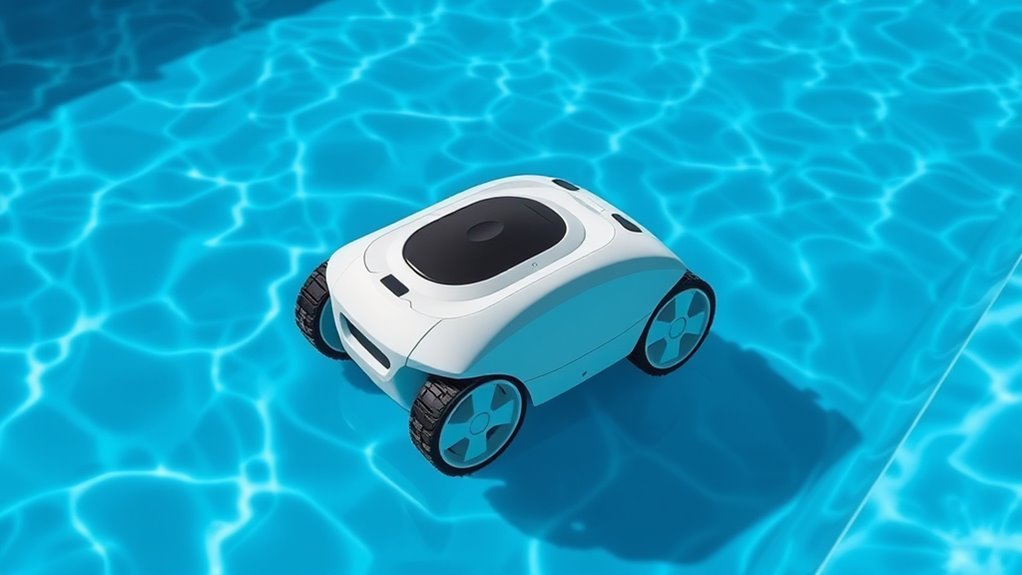
Robotic pool cleaners offer significant advantages over traditional cleaning methods by providing consistent and efficient maintenance with minimal effort on your part. They operate quietly and automatically, saving you time and energy. Eco-friendly operation is a key benefit; these cleaners use less water and chemicals, reducing environmental impact. Plus, their energy-efficient design lowers electricity costs, making them more cost-effective over time. Unlike manual skimming or suction-side cleaners, robotic models can target hard-to-reach areas and thoroughly clean the entire pool surface. They often come with programmable schedules, so your pool stays clean without daily intervention. Overall, robotic pool cleaners keep your pool pristine, save money, and promote environmentally responsible maintenance—all while freeing you from tedious chores.
Frequently Asked Questions
How Long Do Robotic Pool Cleaners Typically Operate on a Single Charge?
Robotic pool cleaners usually run for about 1.5 to 2 hours on a single charge, depending on the model. Your device’s battery life determines how long it can clean before requiring a recharge. After finishing, you’ll need to wait for the charging time, which typically takes 2 to 3 hours. Keeping an eye on the battery life helps guarantee your cleaner gets the job done efficiently without interruption.
Can Robotic Pool Cleaners Handle Debris of All Sizes and Types?
Did you know robotic pool cleaners can handle debris of various sizes? They’re designed to clean different pool surfaces efficiently. You’ll find most models can pick up debris as small as dirt and as large as leaves or twigs. Whether it’s a smooth surface or textured, these cleaners adapt well, ensuring your pool stays spotless regardless of debris size or type, making maintenance much easier for you.
Are Robotic Pool Cleaners Suitable for All Pool Shapes and Sizes?
Robotic pool cleaners are generally suitable for most pool shapes and sizes, but you should consider your pool’s surface and depth. They adapt well to various surfaces like concrete, tile, or vinyl, and handle different depths efficiently. However, for very large or uniquely shaped pools, check the cleaner’s specifications to confirm it covers the entire surface and reaches the deepest areas, providing thorough cleaning without hassle.
How Often Should I Perform Maintenance on My Robotic Pool Cleaner?
Think of your robotic pool cleaner as a trusty assistant that needs regular check-ins. You should follow a maintenance schedule of at least once a week, especially after heavy use or storms. This keeps it running smoothly. Also, keep troubleshooting tips in mind—clean filters and check brushes regularly. Staying proactive prevents problems and guarantees your cleaner stays in top shape, like a well-oiled machine, ready for action whenever you need it.
Do Robotic Pool Cleaners Require Professional Installation or Setup?
Robotic pool cleaners generally don’t require professional installation; most have simple user setup. You just need to place the device in your pool, connect it to a power source, and program the cleaning schedule. Installation requirements are minimal, making it easy for you to start cleaning without extra help. Follow the manufacturer’s instructions for ideal setup, and you’ll be ready to enjoy a clean pool in no time.
Conclusion
Understanding how robotic pool cleaners work reveals a marvel of modern ingenuity, turning your pool into a crystal-clear oasis with the precision of a skilled artist. Their sensors, algorithms, and cleaning mechanisms dance in harmony, like a symphony of technology and design. With minimal effort on your part, they sweep away dirt and debris, transforming maintenance into a breezy, almost magical experience. Embrace this robotic marvel, and watch your pool shine like a jewel in the sun.
